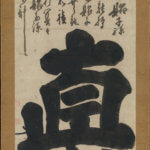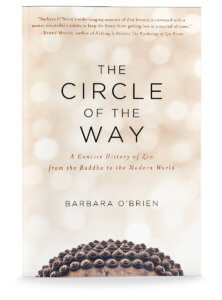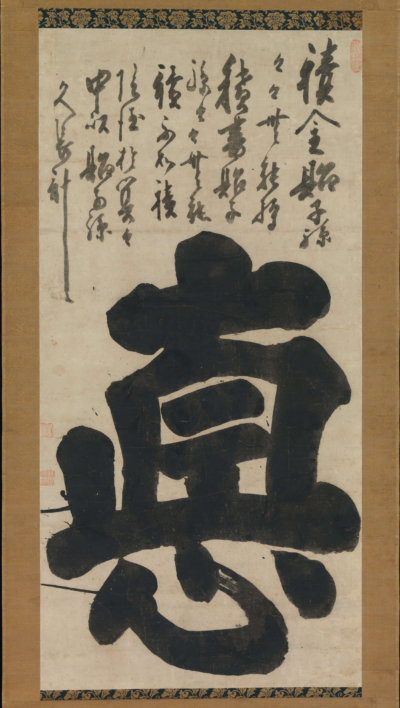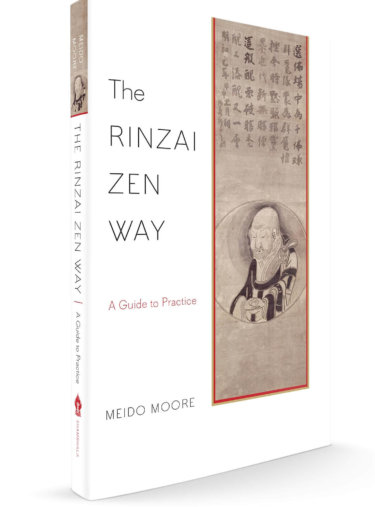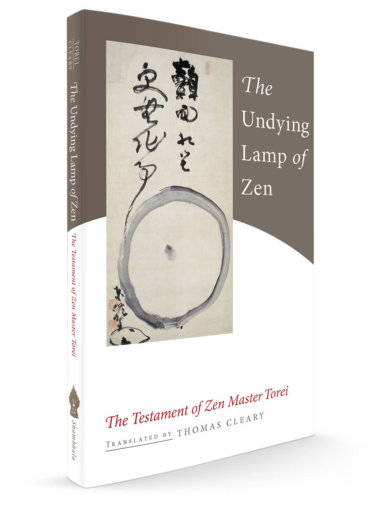
Image by Hakuin. This oversize rendition of the character for “virtue” (toku 徳) reflects the exuberant spiritual energy projected by Ekaku, who was one of the foremost proponents of the revival of the Rinzai sect of Zen Buddhism in late Edo-period Japan. Originally composed by Chinese historian and Confucian scholar Sima Guang (1018–1086).
Explore Zen Buddhism: A Reader's Guide to the Great Works
Overview
Chan in China
- The Works of the Chan and Zen Patriarchs
- The Works of Zen in the Tang Dynasty (618-907)
- The Works of Zen in the Song Dynasty (960 - 1279)
- The Great Koan Collections
Zen in Korea
Zen in Japan
> Rinzai Zen
Additional Resources
- The Heart Sutra: A Reader’s Guide
- Zen in the Modern World (Coming Soon)
- Foundational Sutras and Texts of Zen (Coming Soon)
- Zen and Tea
The Circle of the Way sets the stage for Rinzai in Japan:
The history of the Linji/Rinzai school in Japan followed a very different trajectory from that of Caodong/Soto. While, in Dogen, Soto Zen had one founder, Rinzai had several. Although Eisai is credited with being the first Japanese Linji lineage holder, he did not establish a surviving Rinzai Zen lineage or a Rinzai Zen school independent from Tendai. Instead, several other monks would lay the foundations of what would be Japanese Rinzai Zen. But the most prominent ancestor of today’s Rinzai Zen, Hakuin Ekaku, would not emerge until the eighteenth century.
The first Rinzai founder was Enni Ben’en (1202–80), another former Tendai monk. Enni is said to have studied either with Eisai or one of his students before going to China, where he received transmission from an eminent Chan master named Wuzhun Shifan (1178–1249). When he returned to Japan in 1241, he was given a temple, Tofuku-ji, in Kyoto very near Dogen’s Kosho-ji. It’s believed that by being more accommodating to the aristocracy—for example, by performing esoteric rituals—he attracted patrons away from Dogen, which may have contributed to Dogen’s decision to move away from Kyoto.
But Enni was far from alone. In the thirteenth and fourteenth centuries several Tendai and Shingon Japanese monks traveled to China to receive Linji transmission, and Chinese Linji dharma heirs came to Japan. Nearly all these teachers were from the same branch of Linji, the lineage of Yangqi Fanghui (992–1049). Rinzai Zen quickly became popular with the aristocracy.
Central to the Rinzai tradition is Hakuin (1685–1768) and he is the focus of the next article in this series, but first here are some excellent other sources on the Rinzai tradition and its practices.
The Rinzai Zen Way: A Guide to Practice
Perhaps the best overview of the Rinzai tradition available in English is Meido Moore's The Rinzai Zen Way: A Guide to Practice.
Moore describes how recognition of the true nature of oneself and the universe is the aim of Rinzai Zen—but that experience, known as kensho, is really just the beginning of a life of refining that discovery and putting it into practice in the world. Rinzai, with its famed discipline and its emphasis on koan practice, is one of two main forms of Zen practiced in the West, but it is less familiar than the more prominent Soto school. He remedies that situation by providing this compact and complete introduction to Zen philosophy and practice from the Rinzai perspective. It’s an excellent entrée to a venerable tradition that goes back through the renowned Hakuin Ekaku in eighteenth-century Japan to its origins in Tang dynasty China—and that offers a path to living with insight and compassion for people today.
The Undying Lamp of Zen: The Testament of Zen Master Torei
For a traditional account, Thomas Cleary's translation of The Undying Lamp of Zen: The Testament of Zen Master Torei is an invaluable resource.
This is a complete explanation of Zen practice written by one of the most eminent masters of pre-modern Japan. The author, Torei Enji (1721–1792), was best known as one of two “genius assistants” to Hakuin Ekaku, who was himself a towering figure in Zen Buddhism who revitalized the Rinzai school. Torei was responsible for much of the advanced work of Hakuin’s later disciples and also helped systemize Hakuin’s teachings. The Undying Lamp of Zen includes a range of principles and practices, from the most elementary to the most advanced. It is an indispensable aid to the practice of Rinzai Zen, and provides an accessible entrée to the Zen experience in general. Torei is a compelling guide; his tone is energetic, no-nonsense, and full of personality.

